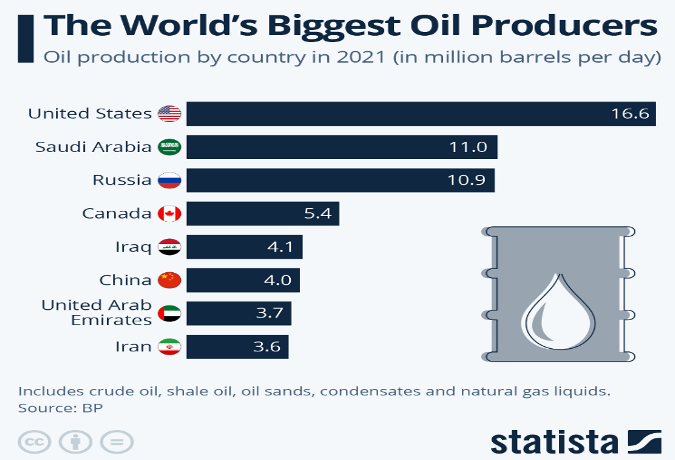Since the financial crisis in 2008, China's role as a global player has become increasingly important, it is no surprise then that this country is currently contributing to global economic growth the most. Therefore, every trade that is trying to gain an advantage in the market should be able to monitor the indicators of the Chinese economy.
And we are not referring to China's influence on stock markets or currencies such as the Australian dollar. China's influence is also dominant in commodity markets. So in this article, we will tell you which 6 indicators of the Chinese economy to watch so that you can form a complete picture of future oil price movements.
The economic position of China in the global world
China's economy is one of the fastest-growing economies of the 21st century and currently, the second largest economy in the world, producing a GDP value of USD 20.25 trillion in 2022. The world leader is still the US with a GDP of USD 25.03 trillion.
Figure 1: GDP in 2022 (USD billion), source www.Knoema.com
This, of course, shows the vital role China plays in the global economy. But few people know that China is also one of the world's largest oil producers.

Figure 2: World oil producers
As the world's sixth largest oil producer, China has long been self-sufficient in terms of oil consumption and could even afford to export the commodity. In 1973, China began exporting oil to Japan, and exports rose to 20 million tonnes in 1985. However, since 1993, internal demand for oil has exceeded domestic production and China has since become a net importer of oil. Currently,
China is the world's largest oil importer ahead of the US.
The size of the Chinese economy and its oil consumption obviously have a major impact on oil prices. For example, the IEA predicts that China will drive half of the growth in world oil demand this year, and
may even force OPEC+ to reconsider production curbs. Also, Wood Mackenzie expects China to account for about 40% of the global oil demand recovery in 2023.
This shows that there are enough reasons to take a closer look at the main Chinese economic indicators that may hint at the further development of the oil price.
Indicator 1: Gross domestic product
The most important indicator to monitor is the gross domestic product, which determines the performance of an economy. In the case of China, the constraints due to the zero-Covid policy have had a strong negative impact on the performance of the economy until recently. This was abolished in China in early December last year, and a wave of deferred purchases from accumulated savings is expected to come in to support the performance of the Chinese economy.
So far, however, data on China's economic performance in early 2023 have been relatively mixed. Therefore, it is expected that government officials could decide on some form of economic stimulus to boost economic growth.
The impact of GDP on the oil price can be seen in the following chart.
Chart 3: WTI crude oil on H1 chart
On Jan. 17, 2023, China reported a GDP of 2.9%, which was better than analysts' expectations. This value was a bullish signal for crude oil and the price continued its uptrend to the nearest resistance level.
Indicator 2: Industrial production
The industrial production indicator shows the change in output produced by industrial enterprises, mining output, and the output of utility companies that maintain infrastructure. This area used to be a big driver of the Chinese economy and also had a major impact on oil demand.
China's industrial production growth in January and February 2023 was up 2.4% year-on-year (versus 1.3% year-on-year growth in December). However, this is still a weak growth rate compared to pre-COVID-19 pandemic trends, as industrial production was growing at around 5% until 2020.
Among the industrial production indicators,
we can include a sentiment indicator called the manufacturing PMI, which is the purchasing managers' index for the manufacturing sector. China reports two types of PMI - Caixin Manufacturing PMI and Manufacturing PMI. Manufacturing PMI value. The value of this indicator for March reached 51.9, which indicates the expected expansion of the sector.
We will see how the oil price reacts to the PMI in another example, when on 1 February 2023 China reported a Caixin PMI value of 49.2. A value below 50 indicates an expected decline in economic activity. At the same time, the value was worse than analysts' expectations. Oil's first reaction to the report was neutral, but then oil began to weaken sharply in the afternoon US session.
Chart 4: WTI crude oil on the hourly chart
At the same time, this fundamental complemented the conclusions of the technical analysis, as it can be seen that at that moment oil was in a downtrend, within which a pullback was formed. Entries on the pullback of an ongoing trend are then one of the opportunities where a trade can be made with a favorable risk/reward ratio.